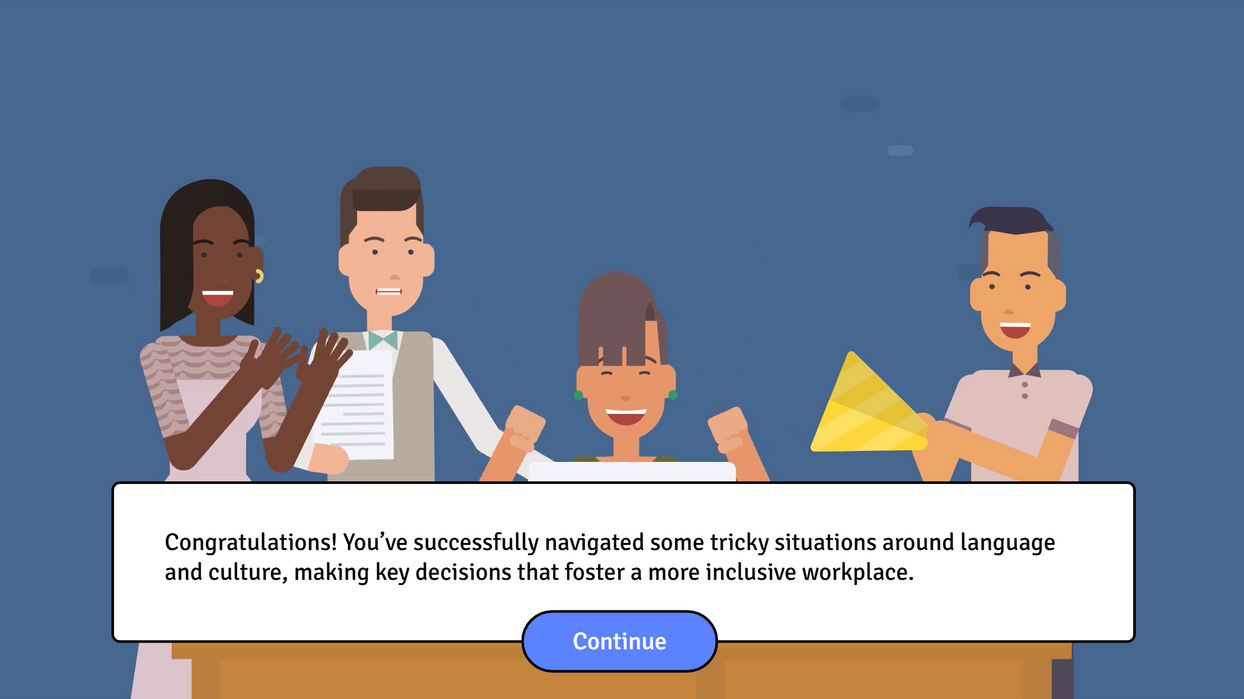SCENARIO-BASED LEARNING
AUDIENCE
Managers at a financial institution
LEARNING GOAL
Foster an inclusive work culture through linguistics
RESPONSIBILITIES
Instructional design, e-learning development, prototyping, needs analysis, action mapping, storyboarding/content creation, visual design, text-to-speech and sound effects, video production and editing
SOFTWARE USED
Storyline 360, Vyond, Notion, Canva, Mindmeister, Murf AI, ElevenLabs, PlayHT, ChatGPT, Google Docs, Google Cloud
MY PROCESS
I followed a structured design and development process to bring this project to life. This included conducting a needs analysis, creating an action map, writing a detailed storyboard, prototyping, and refining the final product based on feedback.
Needs Analysis
I conducted a needs analysis for my concept project to gather information in order to answer to the following questions:
-
Who is my audience?
-
Who is my client?
-
Who is the learner?
-
What is the performance problem?
-
Is the problem caused by a lack of knowledge of skill?
-
What are the consequences to the client and learners?
-
What are the potential solutions?
-
Which elements will the eLearning project include?
-
What’s the setting for the project’s story?
After obtaining the answers to these questions, I was able to identify the high-priority actions, focusing on what the learner needs to do instead of what they need to know.

Fostering an Inclusive Culture through Linguistics
This scenario-based elearning project helps managers at Horizon Bank integrate social dialects into workplace culture, fostering inclusivity and increasing employee satisfaction.
This is a concept project designed to showcase my instructional design process.
Action map: I used an action map to identify key actions that will help learners achieve the performance goal.
Action Mapping
Working closely with SMEs, I created an action map to identify high-priority actions for the learners. The focus was on behavior change rather than passive knowledge transfer. This ensured the course centered around what managers need to do to foster inclusivity.
.png)
Pages from the text-based storyboard: I used a storyboard to write the content of the full e-learning experience.


Text-based Storyboard
The text-based storyboard served as the blueprint for the course. I developed an engaging narrative that immersed managers in realistic situations and allowed them to experience the consequences of their decisions in a risk-free virtual environment. A mentor character, Ace, guides learners throughout the experience, offering on-demand support.
Initial draft of the style guide, some slides of the mood board and initial wireframes drafts.
Visual Mockups
To establish a cohesive visual identity, I created a mood board and style guide. These informed the design of wireframes and mockups, ensuring consistency across all slides.
Final scene of positive consequence from first scenario.
Final scene of negative consequence from first scenario.
Interactive Prototype
I built an interactive prototype using Storyline 360 to collect feedback on functionality and user experience. The prototype focused on several interactive slides and the first scenario-based question. Prototyping only this short part of the course allowed me to gather valuable feedback on the design and interactivity early in the process, enabling me to implement changes throughout the rest of the project without having to rework the entire experience.
.jpg)
.png)
Various slides from all scenarios in the full learning experience.
Full Development
After applying feedback from the prototype, I developed the final product. Key features include:
-
Interactive decision-making scenarios with immediate feedback
-
Realistic dialogue to immerse learners in workplace dynamics
-
Mentor guidance for on-demand learning support
Final slide of the learning experience.
Results and Takeaways
While this was a concept project, the final product demonstrates the potential to:
-
Increase employee satisfaction scores by 25%, aligning with Horizon Bank’s goals.
-
Reduce biased language in performance reviews and promote inclusive leadership practices.
-
Enhance understanding and respect for diverse communication styles across teams.
Lessons Learned:
-
Realistic scenarios resonate with learners and encourage behavior change.
-
Collaboration with SMEs ensures the content addresses real-world challenges.
-
Feedback during prototyping is invaluable for refining the final product.
If I were to implement this project further, I’d incorporate metrics to track long-term improvements in employee satisfaction and inclusivity in alignment with company goals.
.png)
























